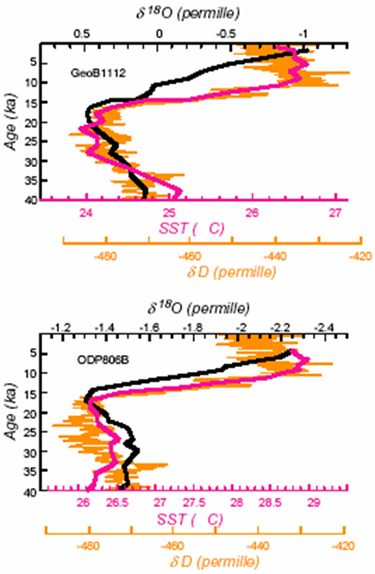|
Spatial variations of the phaseshift between ocean surface warming, evaporation and changes of continental ice volume at terminations I and II
Principal Investigators: Anton Eisenhauer (IFM-GEOMAR Kiel), Dirk Nürnberg (IFM-GEOMAR Kiel), Thomas Blanz (University of Kiel)
Project Scientists: Christian Horn (IFM-GEOMAR Kiel), NN (IFM-GEOMAR Kiel)
Combined planktonic foraminiferal Mg/Ca and δ18O data from the West Pacific Warm Pool (ODP Site 806B, Lea et al. [2000]) and from the equatorial East Atlantic (GeoB1112, Nürnberg et al. [2000]) in relationship to the Antarctic ice core deuterium isotope record. Note that Mg/Ca leads δ18O by several thousand years. The SST increase appears to be synchronous with the Vostok deuterium isotope record, which reflects atmospheric warming over Antarctica.
The proposed study will examine the warming of the ocean surface during the beginning of interglacial Marine Isotope Stages 1 and 5. Primary goal is to verify the hypothesis whether the tropical ocean or the northern North Atlantic is pacing climate change at the beginning of interglacials. The change in sea-surface temperature in relation to sea-surface salinity and global ice volume change will be deciphered by using a hitherto unique approach, namely the measurement of combined 44/40Ca, Mg/Ca and δ18O in the same planktonic foraminiferal species in comparison to alkenone-based temperatures. The high-resolution multi-proxy data series will be gathered from tropical to high northern latitude ocean areas in the Atlantic Ocean, broadly following the transport paths of ocean heat via the Gulf Stream system, and hence, covering areas with different evaporation/precipitation balances. We will reconstruct these oceanic parameters for the surface ocean (using shallow-dwelling foraminifers) and for the subsurface ocean (using deep-dwellers). In order to improve and cross-check the interpretation of the paleo-data, model simulations of the atmospheric hydrological cycle, evaporation and precipitation as well as feedbacks involving atmospheric dynamics during the beginning of interglacials will be carried out.
The change in sea surface temperature in relation to salinity and global ice volume change will be deciphered by measuring combined δ44/40Ca, Mg/Ca, and δ18O in the same planktonic foraminiferal species in comparison to alkenone-based temperatures. The multi-proxy data series across Termination I and II will be gathered from tropical to high northern latitude areas in the Atlantic Ocean, broadly following the transport paths of ocean heat via the Gulf Stream, and hence, covering areas with different evaporation/precipitation balances. Model simulations of the atmospheric hydrological cycle, evaporation and precipitation, and feedbacks involving atmospheric dynamics during Terminations will be carried out.
|
| < Prev | Next > |
|---|


